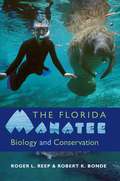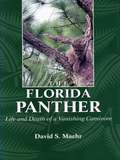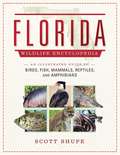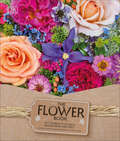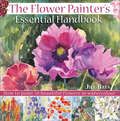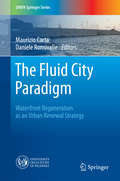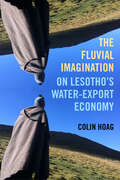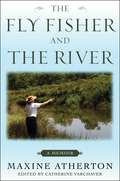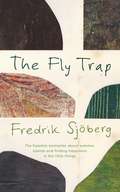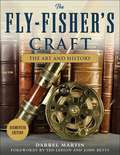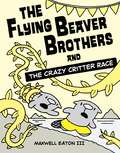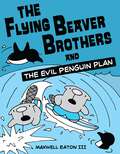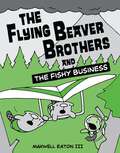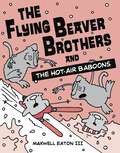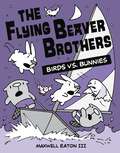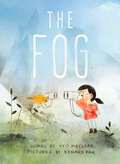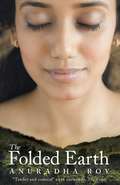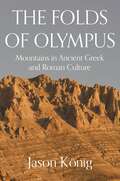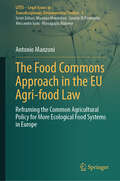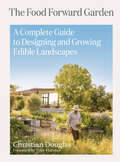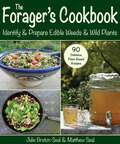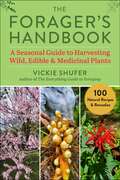- Table View
- List View
The Florida Manatee: Biology and Conservation
by Roger L Reep Robert K BondeMuch of what we know about manatee biology and behavior has been learned in the years after they were first declared an endangered species in 1967. Roger Reep and Robert Bonde have been at the forefront of manatee research for more than two decades. The Florida Manatee offers an engaging, accessible introduction to everything manatee, including communication, diet, long-distance migration, and much more.Publication of the hardcover edition birthed a slew of national newspaper stories on manatee intelligence appearing in publications ranging from the New York Times to the Pittsburgh Post-Gazette as well as dailies throughout Florida. The Florida Manatee is perfect for anyone seeking the most comprehensive, up-to-date information on this fascinating marine mammal.
The Florida Panther: Life And Death Of A Vanishing Carnivore
by David MaehrWhen the first field study of the Florida panther took place in 1973, so little was known about the animal that many scientists believed it was already extinct. During more extensive research conducted from 1981 to 1986, panthers were proven to exist, but the handful of senile, anemic, and parasite-infested specimens that were captured indicated a grim future. During those early years a remarkably enduring image of the panther was born, and despite voluminous data gathered over the next decade that showed the panther to be healthy, long-lived, and reproducing, that earlier image has yet to be dispelled. For nine years, biologist David S. Maehr served as project leader of the Florida Panther Study Project, helping to gather much of the later, surprisingly positive data. In The Florida Panther, he presents the first detailed portrait of the animal -- its biology, natural history, and current status -- and a realistic assessment of its prospects for survival. Maehr also provides an intriguing look at the life and work of a field biologist: how captures are made, the intricacies of radio-telemetry tracking, the roles of various team members. He describes the devastating intrusion of politics into scientific work and examines controversial efforts to establish a captive breeding program and to manipulate the Florida panther's genetic stock with the introduction of relatives from west Texas. Protection of high-quality habitat, much of it in the hands of private landowners, is the key to the long-term survival of the Florida panther. Unless agency decisionmakers and the public are aware of the panther's true situation, little can be done to save it. This book will play a vital role in correcting widespread misconceptions about the panther's current condition and threats to its survival.
The Florida Wildlife Encyclopedia: An Illustrated Guide to Birds, Fish, Mammals, Reptiles, and Amphibians
by Scott ShupeFlorida’s wildlife has always played an important role in the history of human beings inhabiting the state. Native Americans depended on birds, mammals, and fish for sustenance. The state’s first European explorers encountered new and intimidating species like the American Alligator and the Eastern Diamondback Rattlesnake. In later years “plume hunters,” ventured into the Florida wilderness in search of enormous rookeries of herons and egrets, killing an abominable number of birds for feathers that were used to adorn the hats of fashionable ladies. Meanwhile the American Alligator was hunted to near extinction for its tough, scaly hide that made durable leather for luggage and boots. Although the state’s wildlife is still an important resource for human consumption, wildlife is also increasingly important in today’s culture for its intrinsic, aesthetic value. For many Floridians, the age-old traditions of hunting and fishing have been replaced by a desire to simply observe wildlife and experience nature. But most Floridians are largely unaware of the diversity of species inhabiting their state. This volume is intended to provide an introduction to the state’s fresh water fishes, amphibians, reptiles, birds, and mammals. In Florida Wildlife Encyclopedia, nationally known naturalist Scott Shupe has collected information on all the native wildlife that reside in the Sunshine State. The fifth in a series of state wildlife encyclopedias, this book will be a handy, usable, layman’s guide to Florida’s native wildlife. Included are over 700 color photographs, depicting the different species of mammals, reptiles, amphibians, birds, and fish, while also offering over 600 range maps to show their territory. Along with basic information for the biology of each animal, Shupe includes the size, habitat, and abundance of each species located in the state. Whether you’re a lover of the outdoors, photography, or are looking to learn more about your state, this comprehensive guide will teach you about the wonderful wildlife that covers the water, earth, and skies of Florida.
The Flower Alphabet Book (Jerry Pallotta's Alphabet Books)
by Jerry PallottaRoses are red,Violets are blue...And they're only two of the flowers in this book of bright colors and delightful information. Young readers will be fascinated to find out what flower can be used to make a doll, which flower flavors tea, and which flower farmers feed to chickens.Author Jerry Pallotta and illustrator Leslie Evans have collaborated to produce a stunning bouquet of words and pictures about the world of flowers–one of nature's most beautiful gifts.
The Flower Book: Let the Beauty of Each Bloom Speak for Itself
by Rachel SiegfriedExplore 60 flowers, bloom by bloom, in stunning portraiture with lush macrophotography that showcases the details of each flower, and learn how to arrange flowers with different styles, tips, and techniques.Intimate portraits of each flower include quick-reference profiles with tips for choosing the best blooms, care for cut stems, arranging recommendations, colors, shapes, and even growing tips to transform the home, from yard to tabletop. Study a multitude of blooms, from the amaryllis in spring, snapdragon in summer, and dahlia in fall to tropical wonders such as orchids and African lilies.The Flower Book spotlights 30 sample floral arrangements that show how to design and build custom floral arrangements using featured blooms. Plus, a step-by-step techniques section walks beginners through the basics of foliage and fillers, bouquets, and arrangements to make this book as practical as it is beautiful.A perfect gift for anyone who loves flowers, The Flower Book celebrates all the wonderful qualities of flowers—their sheer beauty, infinite variety, and power to evoke admiration—bloom by exquisite bloom.
The Flower Painter's Essential Handbook: How to Paint 50 Beautiful Flowers in Watercolor
by Jill BaysHelp your artistic talent bloom by capturing the beauty of flowers with your brushstrokes from realistic close-ups to impressionistic landscapes. From Agapanthus to Water Lily, this unique artist&’s reference provides easy-to-follow, plant-specific information on how to paint fifty of today&’s most popular flowers. • Learn to draw each basic flower shape and then paint a single detailed bloom • Gain full, practical guidance for painting each flower through clear illustrations, step-by-step instruction, and the essential color palette • Refer to Jill&’s beautiful finished paintings for further inspiration • Use the indispensable introduction to discover basic flower painting materials, techniques and color considerations The must-have practical reference that no flower painter can be without!
The Fluid City Paradigm
by Maurizio Carta Daniele RonsivalleThis book presents a new paradigm of knowledge and action withrespect to urban waterfronts and the "fluid city paradigm,"explaining its methodological framework and describing an integrated andcreative planning approach in which waterfront regeneration is pursued as a keyurban-renewal strategy. It focuses especially on the WATERFRONT project ("WaterAnd Territorial policiEs for integRation oF multisectoRial develOpmeNT"), whichwas funded jointly by Italy and Malta with the goal of developing commonguidelines, strategies, and operational tools for the planning of coastal areas,based on cross-border exchange of experiences. In the described approach, thewaterfront is recognized as having a broad identity, acknowledging thecomplexity of the relationship between seaport and town and taking into accountthe physical and environmental components of human settlement, infrastructure,and productive and recreational activities. It highlights details of theprocess of renewal in the port city of Trapani, with discussion of theimplemented actions, plans, and programs. The book also examines the practicesadopted to transform city-port relationships across Europe in pursuit ofinnovative and sustainable development.
The Fluvial Imagination: On Lesotho's Water-Export Economy (Critical Environments: Nature, Science, and Politics #12)
by Colin HoagA free open access ebook is available upon publication. Learn more at www.luminosoa.org. Landlocked and surrounded by South Africa on all sides, the mountain kingdom of Lesotho became the world's first "water-exporting country" when it signed a 1986 treaty with its powerful neighbor. An elaborate network of dams and tunnels now carries water to Johannesburg, the subcontinent's water-stressed economic epicenter. Hopes that receipts from water sales could improve Lesotho's fortunes, however, have clashed with fears that soil erosion from overgrazing livestock could fill its reservoirs with sediment. In this wide-ranging and deeply researched book, Colin Hoag shows how producing water commodities incites a fluvial imagination. Engineering water security for urban South Africa draws attention ever further into Lesotho's rural upstream catchments: from reservoirs to the soils and vegetation above them, and even to the social lives of herders at remote livestock posts. As we enter our planet's water-export era, Lesotho exposes the possibilities and perils ahead.
The Fly Fisher and the River: A Memoir
by Maxine Atherton Catherine VarchaverOn angling as a woman in the first half of the twentieth century.Like fast moving currents, the fishing tales in The Fly Fisher and the River move us through a selection of Max Atherton’s experiences both within rivers’ waters as well as at their outer edges. They remind us that alongside the (then-) radical environmentalist-explorer part of her, there was a playful joie de vivre, someone who appreciated the company of good-looking, intelligent outdoorsmen. Even before her husband’s death, Max enjoyed the attention she got as a fisherwoman. While she cherished a few female friendships, Max held the opinion that women did not generally engage their minds as much as they could and tended to settle for less in their lives than she was willing to. The men she liked-educated, with leisure time to fish-had more freedom and could have adventures and talk about ideas, politics, and the intricacies of fly fishing. This refined form of angling provided an escape from the mundane, and Max enjoyed the adrenaline rush of fishing and camping in the great outdoors as much as the meditative quiet time in nature. Her expertise provided the entrée she needed to thrive in a man’s world-a fact reflected in her writing about the joys of casting her lines into one river after another.Skyhorse Publishing is proud to publish a broad range of books for fishermen. Our books for anglers include titles that focus on fly fishing, bait fishing, fly-casting, spin casting, deep sea fishing, and surf fishing. Our books offer both practical advice on tackle, techniques, knots, and more, as well as lyrical prose on fishing for bass, trout, salmon, crappie, baitfish, catfish, and more. While not every title we publish becomes a New York Times bestseller or a national bestseller, we are committed to publishing books on subjects that are sometimes overlooked by other publishers and to authors whose work might not otherwise find a home.
The Fly Trap
by Fredrik SjöbergFredrik Sjöberg's Swedish bestseller about summer, islands, freedom and boundaries.'The light, the warmth, the smells, the mist, the birdsong - the moths. Who can sleep? Who wants to?'Fredrik Sjöberg finds happiness in the little things. Millions of them, in fact. This beguiling bestseller is his unique meditation on collecting hoverflies. It is also about living on a remote Swedish island, blissful long summer nights, lost loves, unexpected treasures, art, nature, slowness, and how freedom can come from the things we least expect.'Full of charm, a book about how to find meaning in life' Melissa Harrison, The Times, Books of the Year'I often return to The Fly Trap, it remains close to my heart. The minute observations from nature that reveal sudden insights into one's life. Sometimes I almost think that he wrote it for me' Tomas Tranströmer, winner of the Nobel Prize in Literature'Charming, witty and original' Patrick Barkham, Guardian 'Nature writing that can laugh at itself, a real tonic' Gregory Day, Sydney Morning Herald'Delightful, at once informative and often humorously digressive . . . a humane man of wide-ranging curiosity, Sjöberg writes with infectious passion' Paul Binding IndependentFredrik Sjöberg collects hoverflies on the island Runmarö, in the archipelago east of Stockholm. He is also a literary critic, translator, cultural columnist and the author of several books including The Art of Flight and The Raisin King, which form a trilogy with The Fly Trap.
The Fly-Fisher's Craft: The Art and History (Lyons Press Ser.)
by Ted Leeson Darrel Martin John BettsAn illustrated guide to historical and modern flies, hooks, lines, and loop rods.Whether looking for a back-to-basics approach to fly-tying or a better understanding of its history, The Fly-Fisher’s Craft is the perfect volume to educate the curious angler as well as to provide tips of the trade. A detailed history of fly-tying and historical flies are coupled with the author’s personal modern fly patterns, satisfying the fisher’s desire for the pastoral and practical.In The Fly-Fisher’s Craft, experienced outdoors writer Darrel Martin provides thoroughly researched history and careful instruction accompanied by color photographs throughout. Chapters cover a wide variety of topics, such as:Tying in antiquityFly designPersonal patternsHooks and linesLoop-rodsAnd much more!In a newly augmented edition, new readers will have the chance to discover the roots of fly fishing and fly tying from antiquity up through the modern era. With forewords by Ted Leeson and by John Betts, both respected angling authors, this book is a complete source for the fly-tier.Skyhorse Publishing is proud to publish a broad range of books for fishermen. Our books for anglers include titles that focus on fly fishing, bait fishing, fly-casting, spin casting, deep sea fishing, and surf fishing. Our books offer both practical advice on tackle, techniques, knots, and more, as well as lyrical prose on fishing for bass, trout, salmon, crappie, baitfish, catfish, and more. While not every title we publish becomes a New York Times bestseller or a national bestseller, we are committed to publishing books on subjects that are sometimes overlooked by other publishers and to authors whose work might not otherwise find a home.
The Flying Beaver Brothers and the Crazy Critter Race (The Flying Beaver Brothers #6)
by Maxwell EatonThe race is on for Ace and Bub in their sixth adventure in this popular young graphic novel series, which Kirkus called &“funny from the first panel!&” Ace and Bub are tangled up in an island-hopping competition, and there&’s more than just the grand prize—a houseboat!—at stake. The salesman and sponsor is Crazy Critter (and he really is craaazy), and it soon becomes clear that he has more than publicity for his houseboat dealership to gain from the race. Before long, the brothers are wrapped up in the plot: a fast-growing vine is entangling all the nearby islands! Which of their fellow competitors can help them put a stop to this outbreak—and which ones are behind it?
The Flying Beaver Brothers and the Evil Penguin Plan (The Flying Beaver Brothers #1)
by Maxwell EatonMeet Ace and Bub, the flying beaver brothers! Ace loves extreme sports and is always looking for a new adventure. Bub loves napping and, well, napping. But when penguins threaten to freeze Beaver Island for "resort and polar-style living," the brothers put their talents to work saving their tropical island paradise. Can they save Beaver Island from environmental destruction? And can they do it in time to still win the annual Beaver Island Surfing Competition?
The Flying Beaver Brothers and the Fishy Business (The Flying Beaver Brothers #2)
by Maxwell EatonThe Flying Beaver Brothers are back, and this time they're hot on the trail of another eco-villain: Fish Stix Environmental Manufacturing. When Fish Stix sets up shop, most of the islanders are thrilled. After all, Fish Stix are the most popular, best-selling sticks around AND they're good for the environment! But this eco-friendly facade is just a cover for a nefarious plot involving dirty money, fish who walk on dry land, and a great big smoking volcano. It's up to the dauntless beaver brothers to set things right—and they better do it fast or the island's forests are history! Now if only Bub can stop napping and they can all make enough pancakes to save the day. . . .This second installment to Max Eaton's new graphic series ups the ante in terms of both action and humor. The Flying Beaver Brothers are poised to take off as beloved comicbook heros.
The Flying Beaver Brothers and the Hot Air Baboons (The Flying Beaver Brothers #5)
by Maxwell EatonIn the fifth adventure of this popular young graphic-novel series perfect for fans of Captain Underpants and the Lunch Lady series, our bucktoothed heroes are up against a band of baboon bandits. It&’s winter break, and Ace and Bub are hitting the slopes! But their ski session is interrupted by a sudden influx of . . . swimming pools? A band of enterprising baboons has graced Beaver Island with the Easy Breeze, a giant hair dryer designed to melt all the snow off the mountains and channel it into swimming pools. The residents of Beaver Island are over the moon about their new relaxation stations, but Ace and Bub don&’t trust these monkeys any farther than they can ski down a hill with no snow. Can they uncover the baboons&’ real plan before their neighbors become too attached to the summery island makeover? With environmental themes, laugh-out-loud humor, and fast-paced adventures, the Flying Beaver Brothers are sure to fly off bookshelves!
The Flying Beaver Brothers and the Mud-Slinging Moles (The Flying Beaver Brothers #3)
by Maxwell EatonThe Flying Beaver Brothers are back! All is not well on Beaver Island. Ace and Bub have noticed a number of things (trees, houses, evil penguins) sinking into the ground. They soon discover that Captain Jo Jo and his scurvy crew of mud-making moles have hatched a nearsighted plot to steal dirt from Beaver Island to make their own island home even bigger! Can Ace and Bub stop their brotherly bickering and save Beaver Island before it disappears forever?
The Flying Beaver Brothers: Birds vs. Bunnies (The Flying Beaver Brothers #4)
by Maxwell EatonIn their fourth adventure, the Flying Beaver Brothers set off in their sailboat to enjoy some well-deserved rest and relaxation at nearby the island. But the birds and bunnies who live on Little Beaver Island have other ideas. Before long, Ace and Bub find themselves embroiled in an all-out war between the feathers and the fuzz. Can the Flying Beaver Brothers bring peace to Little Beaver Island?
The Fog
by Kyo MaclearA clever and whimsical environmental fable about a bird who is a human-watcher from a dynamic author-illustrator duo.Warble is a small yellow warbler who lives on the beautiful island of Icyland, where he pursues his hobby of human watching. But on a warm day, a deep fog rolls in and obscures his view. The rest of the birds don't seem to notice the fog or the other changes Warble observes on the island. The more the fog is ignored, the more it spreads. When a Red-hooded Spectacled Female (Juvenile) appears, Warble discovers that he's not the only one who notices the fog. Will they be able to find others who can see it too? And is the fog here to stay? Kyo Maclear's witty story, brought to life with the delicate, misty artwork of Kenard Pak, is a poignant yet humorous reminder of the importance of environmental awareness.
The Folded Earth
by Anuradha RoyIn a remote town in the Himalaya, Maya tries to put behind her a time of great sorrow. By day she teaches in a school and at night she types up drafts of a magnum opus by her landlord, a relic of princely India known to all as Diwan Sahib. Her bond with this eccentric, and her friendship with a peasant girl, Charu, give her the sense that she might be able to forge a new existence away from the devastation of her past. As Maya finds out, no place is remote enough or small enough. The world she has come to love, where people are connected with nature, is endangered by the town's new administration. The impending elections are hijacked by powerful outsiders who divide people and threaten the future of her school. Charu begins to behave strangely, and soon Maya understands that a new boy in the neighbourhood may be responsible. When Diwan Sahib's nephew arrives to set up his trekking company on their estate, she is drawn to him despite herself, and finally she is forced to confront bitter and terrible truths. A many-layered and powerful narrative, by turns poetic, elegiac and comic, by the author of An Atlas of Impossible Longing.
The Folded Earth: A Novel
by Anuradha RoyIn a remote town in the Himalaya, Maya tries to put behind her a time of great sorrow. By day she teaches in a school and at night she types up drafts of a magnum opus by her landlord, a relic of princely India known to all as Diwan Sahib. Her bond with this eccentric, and her friendship with a peasant girl, Charu, give her the sense that she might be able to forge a new existence away from the devastation of her past. As Maya finds out, no place is remote enough or small enough. The world she has come to love, where people are connected with nature, is endangered by the town's new administration. The impending elections are hijacked by powerful outsiders who divide people and threaten the future of her school. Charu begins to behave strangely, and soon Maya understands that a new boy in the neighbourhood may be responsible. When Diwan Sahib's nephew arrives to set up his trekking company on their estate, she is drawn to him despite herself, and finally she is forced to confront bitter and terrible truths. A many-layered and powerful narrative, by turns poetic, elegiac and comic, by the author of An Atlas of Impossible Longing.
The Folds of Olympus: Mountains in Ancient Greek and Roman Culture
by Professor Jason KönigA cultural and literary history of mountains in classical antiquityThe mountainous character of the Mediterranean was a crucial factor in the history of the ancient Greek and Roman world. The Folds of Olympus is a cultural and literary history that explores the important role mountains played in Greek and Roman religious, military, and economic life, as well as in the identity of communities over a millennium—from Homer to the early Christian saints. Aimed at readers of ancient history and literature as well as those interested in mountains and the environment, the book offers a powerful account of the landscape at the heart of much Greek and Roman culture.Jason König charts the importance of mountains in religion and pilgrimage, the aesthetic vision of mountains in art and literature, the place of mountains in conquest and warfare, and representations of mountain life. He shows how mountains were central to the way in which the inhabitants of the ancient Mediterranean understood the boundaries between the divine and the human, and the limits of human knowledge and control. He also argues that there is more continuity than normally assumed between ancient descriptions of mountains and modern accounts of the picturesque and the sublime.Offering a unique perspective on the history of classical culture, The Folds of Olympus is also a resoundingly original contribution to the literature on mountains.
The Food Commons Approach in the EU Agri-food Law: Reframing the Common Agricultural Policy for More Ecological Food Systems in Europe (LITES - Legal Issues in Transdisciplinary Environmental Studies #3)
by Antonio ManzoniThis book presents a thorough analysis of the innovative food commons approach in relation to the EU Common Agricultural Policy (CAP). The debates surrounding this pivotal European policy have always been robust, and with the ambitious targets outlined by the UN Sustainable Development Goals and the European Green Deal, they are poised to become even more prominent. To effectively realize these objectives, it is imperative to systematically reassess the fundamental structures of our food systems and enact substantive reforms within EU agri-food law and policymaking. The food commons approach represents not only a novel theoretical framework, but also, and foremost, a dynamic socio-political movement that has garnered attention from both researchers and policymakers due to its pioneering nature. Rejecting the prevailing paradigm of absolute commodification of food, this approach endeavours to reconceptualize our food systems through the prisms of ecology, social inclusion, collective governance, and resilience. The overarching objective of this book is to scrutinize the potential of this novel approach to fundamentally reshape the theoretical underpinnings of EU agri-food law, ultimately facilitating the realization of more sustainable and just food systems. The target audience of this book mainly consists of academic researchers, but also practitioners and policymakers working on agricultural and environmental studies, due to its interdisciplinary approach and the originality of its content. Along the same lines, the book will appeal to NGOs, indigenous peoples, and food sovereignty movements around the world.
The Food Forward Garden: A Complete Guide to Designing and Growing Edible Landscapes
by Christian DouglasDiscover a high-style approach to vegetable gardening from award-winning landscape designer Christian Douglas. What if, instead of relegating our vegetable patch to a remote corner of the backyard, we brought it forward? What if we integrated edibles into our decorative landscapes, letting vegetables, herbs, fruits, and berries share prime real estate alongside our patios, pools, even our front walkways? Equal parts inspiration and instruction, and filled with an abundance of ideas and information, The Food Forward Garden is a lushly illustrated guide to how we can make better use of our outdoor spaces without sacrificing style. In this comprehensive manual, award-winning landscape designer Christian Douglas shows us how the intrinsic beauty and seasonal rhythms of edibles bring a new level of purpose, meaning, and stunning visual pleasure to the home garden.
The Forager's Cookbook: Identify & Prepare Edible Weeds & Wild Plants
by Julie Bruton-Seal Matthew SealMore than a recipe book, more than a foraging book, more than a guide to herbal medicine. Discover 90 exciting recipes showcasing weeds that are delicious, nutritious, medicinal, too good to waste—and free!Why should we eat our weeds? Because they are delicious, adding a palate of new flavors in everyday cooking. They are also nutritious and too good to waste. Weeds are actually more nutritious than most of the vegetables we grow or buy. They often have deep roots that loosen the soil and bring minerals up from far below. Weeds can help cover the soil, keep moisture in it, and preserve its fertility. They offer a second crop among our other plants, for free, and are often available in the late winter and early spring when our vegetables are yet to get going. When it's time to weed, the edible weeds can be eaten. Why throw perfectly good food on the compost heap?With weeds, as with all wild plants you may be planning to eat, proper ID is essential. Rule number one is eat only what you are sure of. In this book, Julie Bruton-Seal and Matthew Seal have provided clear photographs and other written identification details for twenty-two common weeds. They also give guidance on how to harvest safely and responsibly. And you'll find ninety delicious recipes highlighting your foraged goodies. Recipes include:Chickweed PestoDaisy TeaDandelion Flower JamElderberry VinegarOrache TartGround Ivy Hot Cross BunsHogweed PaellaMugwort and Mushroom SoupAnd more!
The Forager's Handbook: A Seasonal Guide to Harvesting Wild, Edible & Medicinal Plants
by Vickie ShuferLearn the way of the forager and identify, harvest, and prepare wild plants by season. Have you ever wondered what it would be like to gather wild plants growing around you for your food and medicine instead of a drugstore to treat a common ailment? The Forager's Handbook is an essential guide for living this lifestyle year-round. With more than forty years of experience in the world of plants, forager Vickie Shufer empowers you to maintain and improve your health by following the way of the forager. She highlights plants that are available through each season and how to use those plants for food and medicine. Sustainable harvesting and preparation techniques are included as well as foraging ethics. Other topics include: Forest bathing Plant cyclesPreventive medicineSimple recipes for edible and medicinal plantsAnd so much more Follow the seasons and harvest wild, edible, and medical plants with The Forager's Handbook.
